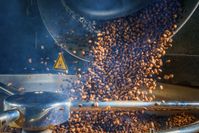Tracing Coffee's Journey From Nature to Your Mug

For many Americans, drinking a cup of coffee—or more—is a daily ritual. While some favor this natural beverage for its caffeine boost and others focus on the flavor, there’s no doubt that coffee is one of the world’s most favorite drinks. But how exactly does this product make it from the farms to your cup? To help illustrate the long and exciting journey of specialty coffee, here are seven major steps of turning beans into a beverage.
7 Steps to Coffee Production
1. Planting
Coffee beans are cultivated in countries throughout the globe—including Brazil, Colombia, Ethiopia, Mexico, Madagascar, Guatemala, and Costa Rica. While the exact length can vary by type, newly planted coffee trees will take about four years to produce usable beans.
2. Harvesting
When planted trees develop bright red coffee cherries, farmers will begin the harvesting process. Many farms will strip the cherries from the branches using special equipment, but some may hand-pick each cherry for quality—especially if the product is a specialty coffee.
3. Processing
Using what’s known as the “wet method” of processing, producers use machinery to separates the bean from the pulp. The beans are then fermented in a water tank and, lastly, dried.
4. Milling, Grading, & Sorting
 During the milling process, equipment is used to remove the outer husk or parchment from the beans. These processed beans are then sorted by quality and size, usually with the help of advanced separation machinery.
During the milling process, equipment is used to remove the outer husk or parchment from the beans. These processed beans are then sorted by quality and size, usually with the help of advanced separation machinery.
5. Distribution
Milled beans are then put into bags and sealed in plastic-coated containers to preserve quality. These massive supplies of beans are then shipped across the world to various countries. Once they reach their destination, specialty coffee is usually tasted for quality to ensure buyers get the best product.
6. Roasting & Packaging
 When roasted at high temperatures, beans turn a dark color and release a natural oil that gives coffee its distinct aroma and taste. Whether ground or left intact to preserve freshness, the finalized product is packaged into a sealed bag or container and sent to individual buyers and retailers.
When roasted at high temperatures, beans turn a dark color and release a natural oil that gives coffee its distinct aroma and taste. Whether ground or left intact to preserve freshness, the finalized product is packaged into a sealed bag or container and sent to individual buyers and retailers.
7. Grinding & Brewing
Right before it is enjoyed, coffee is ground to fit the desired brewing method. Cafes, restaurants, and everyday consumers then use one of several brewing techniques to extract the flavor from the bean and make a delicious and rejuvenating cup of joe.
Although coffee goes through a long journey before it can be enjoyed as a beverage, getting your daily cup is much easier when you visit Main Street Coffee & Wine Bar in Lakeville, MN. Offering a vast selection of specialty coffees, this cozy cafe is a welcoming and lively spot to start your morning, power through the work day, or relax in the evening. If coffee’s not your thing, this venue also offers an impressive selection of wine and beer, as well as box lunches, to tantalize your palate. To learn what they’re currently serving, visit the bar online or call (952) 985-7650.
About the Business
(58 reviews)
Have a question? Ask the experts!
Send your question

